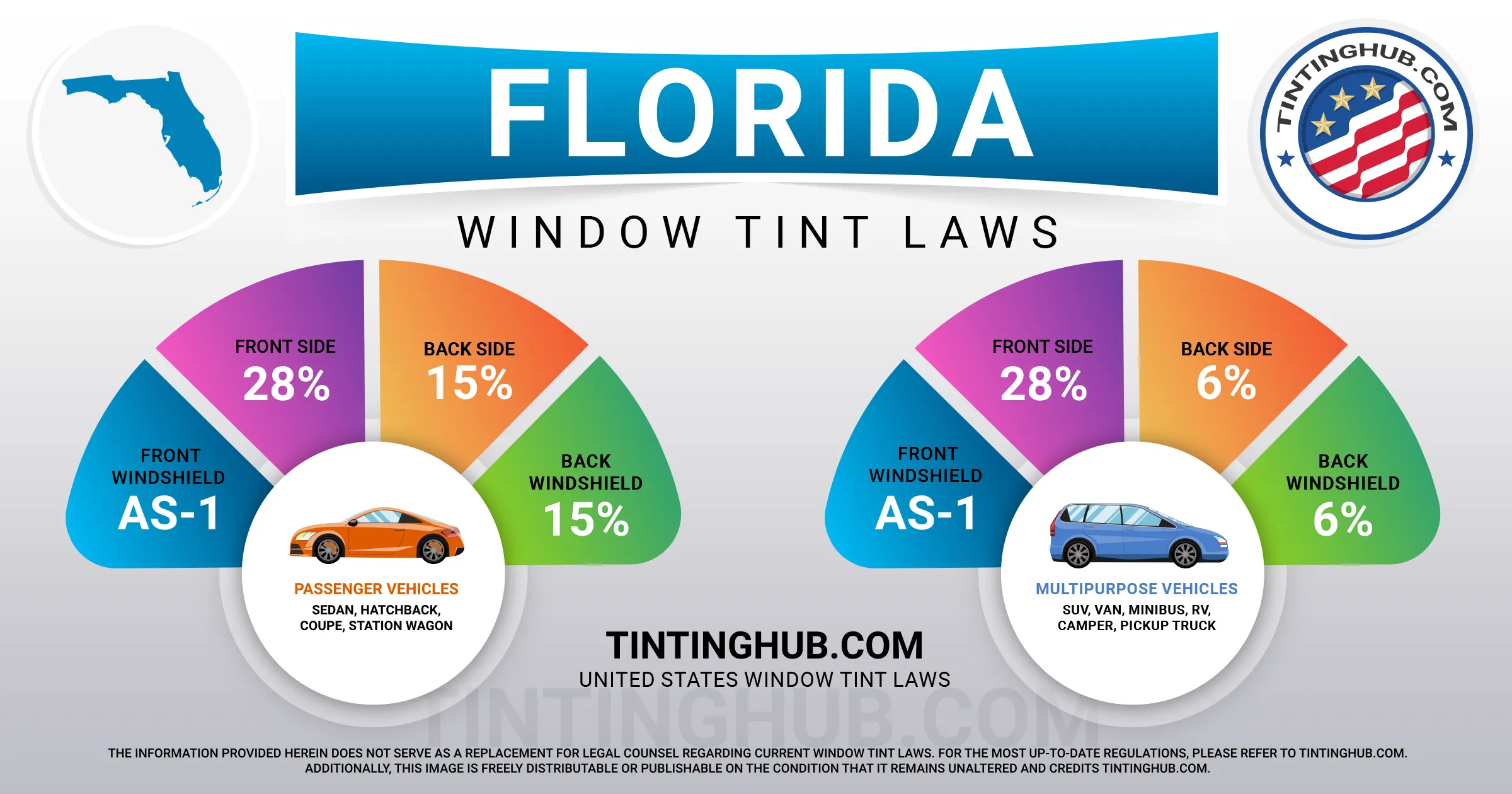Florida introduced car window tinting laws in 1991. Understanding these regulations is crucial to ensure that your vehicle’s windows comply with the state’s requirements. In this comprehensive guide, we’ll walk you through the specifics of Florida’s car window tinting laws and provide clarity on how dark or reflective your tint can be.

Florida’s Window Tint Darkness Rules
In Florida, the darkness of your window tint is measured by VLT, which stands for Visible Light Transmission. The percentage of visible light allowed to pass through your film and glass differs between sedan cars and SUVs/vans.
Tint Darkness for Sedans
- Windshield: Non-reflective tint is allowed above the manufacturer’s AS-1 line.
- Front Side Windows: Must allow more than 28% of light in.
- Back Side Windows: Must allow more than 15% of light in.
- Rear Window: Must allow more than 15% of light in.
Tint Darkness for SUVs and Vans
- Windshield: Non-reflective tint is allowed above the manufacturer’s AS-1 line.
- Front Side Windows: Must allow more than 28% of light in.
- Back Side Windows: Must allow more than 6% of light in.
- Rear Window: Must allow more than 6% of light in.
It’s essential to note that these Florida window tint laws were updated in 2015, and there may still be outdated information on various websites. Always refer to the latest information to ensure compliance with the law.
Window Tint Reflection in Florida
Window tint can reduce glare and heat by reflecting incoming light. However, Florida window tint laws specify the allowable level of tint reflection.
Tint Reflection for Sedans and SUVs/Vans
- Front Side Windows: Must not be more than 25% reflective.
- Back Side Windows: Must not be more than 35% reflective.
Other Florida Window Tint Rules and Regulations
Aside from darkness and reflection, there are other crucial rules and regulations pertaining to window tinting in Florida:
- Side Mirrors: If any back windows are tinted, dual side mirrors are required.
- Restricted Colors: Florida does not permit the use of colored tints.
- Certificates: Film manufacturers are not obligated to certify the film they sell in the state.
- Stickers: A sticker identifying legal tinting is required on the inside of the driver’s side door jamb.
- Medical Exceptions: Florida allows medical exemptions for special tint. For specific terms of exemption, consult your state law.
Keep in mind that Florida’s tinting laws and regulations may be interpreted differently depending on your county or place of residence. Therefore, it’s advisable to double-check this information with your local DMV or law enforcement authorities.
Our information about window tint laws in Florida was last updated in 2023. If you find any outdated or incorrect information, please contact us, and we’ll ensure it gets corrected. We are dedicated to providing accurate and up-to-date information about window tint laws, making us a trusted industry leader in this field.
Real-Life Scenarios and Testimonials
In navigating Florida’s window tint laws, drivers often encounter various scenarios that could lead to confusion or even legal trouble.
For example, John, a Miami resident, found himself facing a hefty fine after mistakenly exceeding the legal tint limit on his SUV. His experience underscores the importance of understanding and strictly adhering to Florida’s specific regulations to avoid similar pitfalls. Hearing directly from individuals who have navigated these waters can offer invaluable insights. Whether it’s choosing the right tint percentage or dealing with law enforcement, these stories illuminate the practical aspects of complying with state laws.
Expert Insights on Window Tinting
To provide our readers with the most accurate and helpful information, we’ve consulted with several automotive experts specializing in window tinting. Their consensus emphasizes not only the aesthetic and protective benefits of tinting but also the critical importance of compliance with Florida’s legal standards. According to Alex Martinez, a certified automotive customization specialist, ‘Choosing the right tint involves balancing legal requirements with your personal needs for privacy and sun protection. It’s not just about enhancing your vehicle’s appearance; it’s about ensuring safety and legality.’ These insights from industry professionals offer a deeper understanding of the nuances involved in window tinting.
Frequently Asked Questions (FAQs)
Florida law stipulates that the front side windows must allow more than 28% of light in, while the back side and rear windows must allow more than 15% of light in for sedans. For SUVs and vans, the same applies to the front side windows, but there are no specified limits for the back side and rear windows.
Yes, if your vehicle’s window tint does not meet the state’s regulations, you may be subject to fines and required to remove or replace the non-compliant tint.
Florida law provides exemptions for individuals with certain medical conditions that require protection from direct sunlight. To qualify, you must obtain a medical exemption certificate from the Florida Department of Highway Safety and Motor Vehicles.
Always consult with a professional window tinting service that is familiar with Florida’s regulations. Additionally, consider using a tint meter to verify the light transmission levels of your window tint.
Read also: How Much is a Ticket for 5% Tint in Florida?